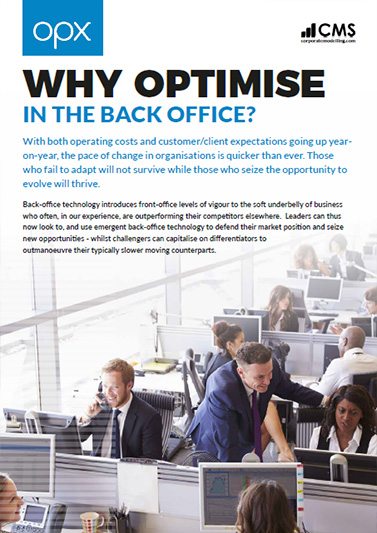Do you know how long your back office processes are taking? And do you have limited visibility of what your back office staff are busy working on? Workforce productivity is usually at the top of most organisations priorities, but when it comes to a contact centres back office, measuring productivity and performance is not always as straightforward as it is for the front office/customer facing agents.
Most companies lack process visibility as well as the relevant tools to improve their back office operations. This means the back office is usually full of hidden opportunities – opportunities to lower operational cost, improve the customer experience and improve quality.
In order to transform your back office, it’s important to start with boosting productivity within it. So, let’s talk through 3 of the most common back office productivity killers and what you can do to stop them.
1. Failure to Track Employee Progress
Do you know which of your employees are truly productive and which are just going through the motions? Tracking work output in the back office can be tricky due to lack of visibility. In order to tackle this, some back office solutions come equipped with a real-time management console. This allows you to monitor live activity as well as meet changes in work volumes.
As well as this, a functional back office solution will provide you with performance and quality metrics of individuals and/or teams to help you identify training needs and development at a task level, ultimately helping you boost employee morale. Reports and dashboards will provide you with management information to drive change and dramatically improve processes by providing visibility on productivity, utilisation and skills. Why not go one step further and profile your over achieving employees? Does work experience, training or certifications make a difference to the success of an employee in your organisation? If you can profile your overachieving employees, then you can recruit or train new members who fit this profile.
2. Failure to Manage Work
Anticipating work processing demand as well as managing resource capacity in the back office is critical in order to meet SLA’s and maintain a successful operation. Some managers may still be using spreadsheets to track work allocation and task progress, which is highly inefficient leading to overstaffing and understaffing. Lacking the visibility to understand how long work items have been in the system can result in a process that is unproductive and inefficient, not to mention demoralising for your employees. Being unable to accurately track work progress, may also mean some companies are at risk of penalties being issued for delayed processing and ultimately lost revenue as clients seek alternative providers.
In order to tackle this, a back office optimisation tool manages productivity in terms of work allocation. Some tools have a real-time workflow functionality which automates work allocation dependent on what is best for the business at the time, the ingest of work and SLA management. As well as this, skills-based workflow functionality ensures your most appropriately skilled staff are handling the right work. Lastly, some tools provide you with additional functionality called ‘Get Next’ which automatically allocates the next task ensuring your agents aren’t ‘cherry-picking’ work. Work is allocated from multiple channels, volumes and type of work based on what is best for the business and customers.
3. Failure to spot Idle Time
Do you know how long your staff’s desktops are idle for? A common issue in the back office is suspected idle time, but not being able to measure it. Idle time may not always mean your staff are being unproductive. Idle time, for example, may be because employees are working on a process that doesn’t require a desktop. Quantifying productivity and measuring idle time isn’t always straightforward.
However, some back office optimisation tools come equipped with an agent time monitoring tool. This allows you to monitor how long your agents are spending on specific tasks, idle time, breaks etc. With this feature you will be able to see exactly what was involved in a work task. For example, an employee may have had their desktop in idle mode as they were dealing with sorting through paperwork associated with an ongoing customer case. Quantifying idle time and really understanding what your employees are working on will help with staff reviews and boosting productivity, giving you visibility into the employees who are going above and beyond as well as those who maintain a consistent level of work quality which your customers will come to appreciate.
Generally, the contact centre back office can fall foul to productivity killers. This is normal as with any business environment – the key here is to utilise technology to help manage this. If you need any advice on your back office, then get in touch with our team who will be able to advise.







 Thank you for your interest in our whitepaper. You can download Workforce Optimisation vs Workforce Management by clicking the button below.
Thank you for your interest in our whitepaper. You can download Workforce Optimisation vs Workforce Management by clicking the button below. Thank you for your interest in our case study. You can download the HCL IBS Case Study by clicking the button below.
Thank you for your interest in our case study. You can download the HCL IBS Case Study by clicking the button below. Thank you for your interest in our case study. You can download the ReAssure Case Study by clicking the button below.
Thank you for your interest in our case study. You can download the ReAssure Case Study by clicking the button below. Thank you for your interest in our case study. You can download the Student Loans Case Study by clicking the button below.
Thank you for your interest in our case study. You can download the Student Loans Case Study by clicking the button below. Thank you for your interest in our case study. You can download the Principality Building Society Case Study by clicking the button below.
Thank you for your interest in our case study. You can download the Principality Building Society Case Study by clicking the button below. Thank you for your interest in our whitepaper. You can download WorkFlow vs WorkForce Management by clicking the button below.
Thank you for your interest in our whitepaper. You can download WorkFlow vs WorkForce Management by clicking the button below. Thank you for your interest in our whitepaper. You can download Homeworking in Financial Services Operations by clicking the button below.
Thank you for your interest in our whitepaper. You can download Homeworking in Financial Services Operations by clicking the button below. Thank you for your interest in our whitepaper. You can download Workforce Optimisation for the Back Office by clicking the button below.
Thank you for your interest in our whitepaper. You can download Workforce Optimisation for the Back Office by clicking the button below. Thank you for your interest in our whitepaper. You can download Operational Workforce Management: Build or Buy? by clicking the button below.
Thank you for your interest in our whitepaper. You can download Operational Workforce Management: Build or Buy? by clicking the button below. Thank you for your interest in our whitepaper. You can download Homeworking & Back Office Workforce Optimisation by clicking the button below.
Thank you for your interest in our whitepaper. You can download Homeworking & Back Office Workforce Optimisation by clicking the button below. Thank you for your interest in our whitepaper. You can download Why Optimise in the Back Office? by clicking the button below.
Thank you for your interest in our whitepaper. You can download Why Optimise in the Back Office? by clicking the button below.